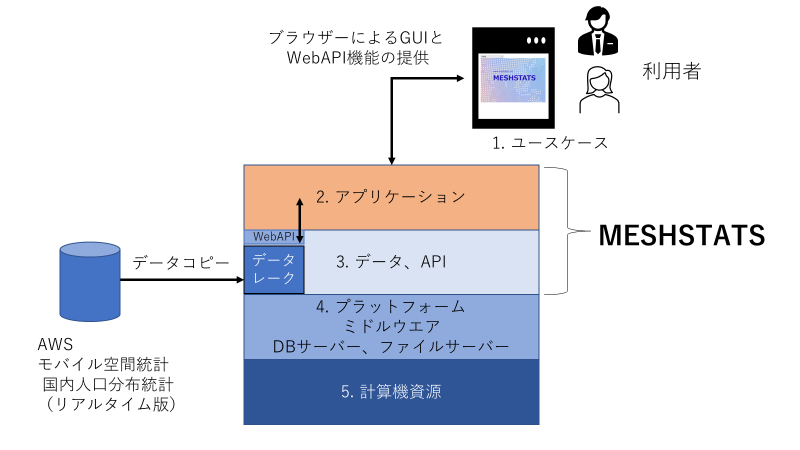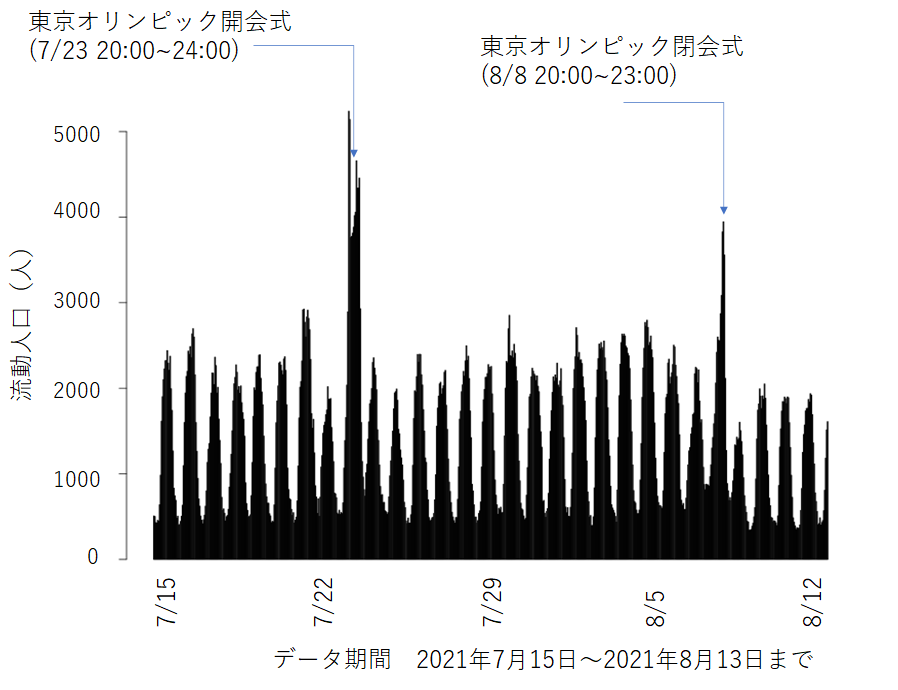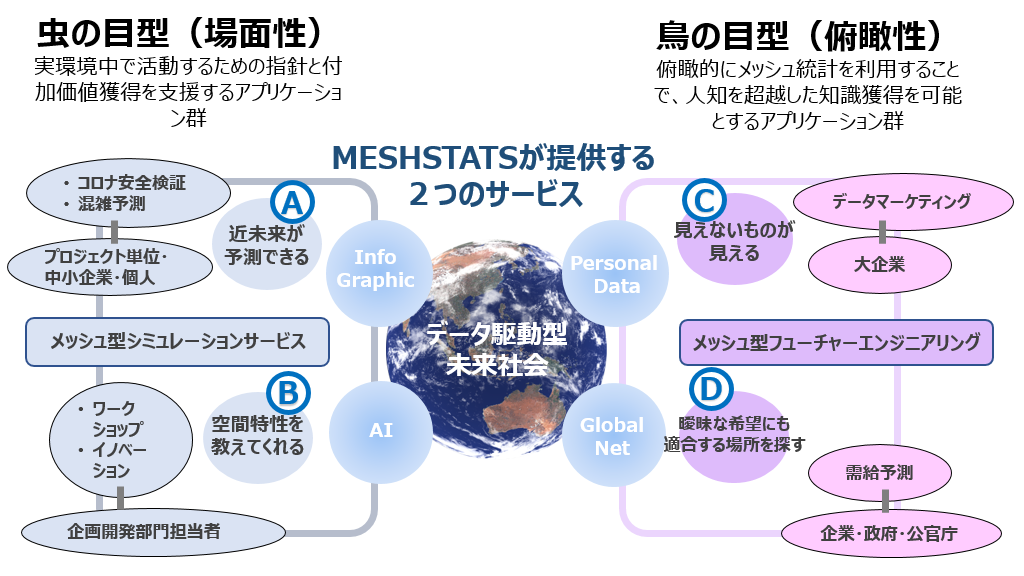A research group led by Professor Akihiro Sato of the Graduate School of Data Science at Yokohama City University, in which Tanseisha participates, developed technical elements that enable the use of mesh statistics *1, and demonstrated real-time observation of activity status during the Tokyo Olympic Games by processing Mobile Spatial Statistics® *2 provided by DOCOMO Insight Marketing, Inc. on the mesh statistics platform (Figures 1 and 2). It is expected that the results of this research will lead to a significant promotion of social utilization of large amounts of currently unused location-related data.
The results of this research will be published in the journal "Journal of the Japanese Society of Applied Statistics" under the title "Approach to the SDGs using an Autonomous Decentralized Global Mesh Statistical Platform" (July 31, 2022, Japan time).
Key findings
1) Statistical quality evaluation method for mesh statistics with 95% confidence interval *3 Formulated by
2) Present examples showing that mesh statistical data is useful in a wide range of areas in society.
3) Formulation of business risk using a cost sharing model based on an autonomous decentralized mesh statistical platform

(Figure 1) Structure of MESHSTATS *4 and demonstration mechanism (demonstration that nationwide 500m mesh statistics provided hourly from the Mobile Spatial Statistics National Population Distribution Statistics (real-time version) provided via AWS can be imported into MESHSTATS and visualized and analyzed on various applications via WebAPI.)

(Figure 2) Using Mobile Spatial StatisticsⓇ to verify activity monitoring during the Tokyo Olympic Games (relevant flow population will be confirmed at the Olympic Stadium in conjunction with the opening and closing ceremonies)
press release
Research Background
Although there are several technologies unique to Japan for mesh statistics, the amount of data to be processed is very large, and the types and formats are extremely diverse. This has prevented the use of mesh statistics from progressing due to the large amount of calculation required. A research group consisting of Yokohama City University, TANSEISHA Co., Ltd., Recruit Co., Ltd., the Institute of Statistical Mathematics, and the National Statistics Center is conducting research and development in collaboration with industry, government, and academia across fields, with the aim of popularizing mesh statistics and utilizing unused data. As part of this, we have been conducting research and development on the autonomous decentralized architecture design of the global mesh statistics infrastructure and the data quality, computer system structure, human organizational structure, and relationships between data flows that are necessary for its demonstration, as well as an ecosystem that is economically and socially sustainable.
This research and development project has set up two types of application groups: "worm's-eye view" and "bird's-eye view." The worm's-eye view application has a function to measure scene characteristics from various mesh statistics and reflect them in decision-making in the real environment, while the bird's-eye view application has a function to measure overview characteristics from various meshes and search for the optimal spatial configuration from the overall view (Figure 3).

(Figure 3) Application classification using mesh statistics platform (insect's eye view, bird's eye view) and users in expected usage scenarios
Research Contents
1) A method for evaluating the statistical quality of mesh statistics is formulated using a 95% confidence interval
Reliability is important for the widespread distribution of data in the "mesh" data format. Yokohama City University and the Institute of Statistical Mathematics have jointly demonstrated a method for evaluating errors in mesh statistics, based on an approximate calculation method using normal distribution for 95% confidence intervals in the estimation of population proportions from sample proportions, and a calculation principle for 95% confidence intervals incorporating a correction method that takes into account sample evaluation errors due to misclassification.
2) Presenting examples showing that mesh statistical data is useful in a wide range of areas in society
In constructing the architecture of an autonomous decentralized mesh statistics platform, we are developing a prototype system called MESHSTATS using an agile development method, prototyping and testing data, application programs, and practical utilization methods, while working to clarify the requirements for them. In addition, in order to overcome the situation where regional mesh codes are a national standard in Japan but not a global standard, we are working on international standardization activities for mesh statistics. On June 30, 2022, it was confirmed that Japan will propose an international standard titled "Mesh Statistics and its Applications" at the ISO/TC69 Domestic Task Force within the Japanese Standards Association. We aim to publish it as an official international standard in the future.
In addition, we are currently examining various applications based on multiple business challenges and challenges in the official statistics of the National Statistics Center.
As a method of using the autonomous decentralized world mesh statistical infrastructure, the research group proposed a method to convert data held by application providers into mesh statistical data, evaluate it while keeping the original data confidential by simply exchanging statistical data, and discover effective application pairs. This method has demonstrated the possibility of overcoming the security issues with data integration that City OS*5 in the smart city field faces.
He also demonstrated a use case scenario using WaaS (Workshop as a Service), which holds data-driven digital design workshops semi-automatically, as part of the functionality of the autonomous distributed mesh statistics platform, based on a case study with TANSEISHA Co., Ltd. He also demonstrated a Tokyo Olympic site activity monitoring system using the API of the Mobile Spatial Statistics National Population Distribution Statistics (real-time version), and by extracting various mesh statistics on movement routes, he measured the flow population density and feature density*6 on movement routes, and linked it to a COVID-19 simulation platform, among other useful applications, their mechanisms, and usage methods.
It is expected that by using the autonomous decentralized mesh statistical platform technology introduced here, it will be possible to build multiple useful applications on the platform and provide services.
3) Formulation of business risk using a cost sharing model based on an autonomous decentralized mesh statistical platform
In the mesh statistics data distribution model, the time and cost required for data preparation is concentrated on the user due to the large amount of data, so distribution and utilization of the data has not progressed so far. Furthermore, the fact that users are required to make a large upfront investment has been an impediment to its widespread use. By developing an autonomous decentralized global mesh statistics platform, we have made it possible to significantly shorten data preparation time, and by calculating the cost of data utilization for each data cost sharing model, we have demonstrated that applications can be used at a realistic cost.
Table 1 shows the estimated payback period for three types of business models. Conventional service I is a case where all necessary mesh statistical data is purchased in advance, and in addition to the initial setup cost R, a data purchase cost Pi is required, and the period shown is the period in which this is amortized through the usage fee c from users. Service II is a case where the proposed system is used as a worm's-eye type application, and the necessary mesh statistical data is purchased locally on demand, and the period shown is the period in which the initial setup cost R is amortized through the usage fee c per user. Service III shows the amortization period when a search problem using a bird's-eye type application for multiple regions is realized by using Service II J times. Model calculations showed that for Services II and III, the application development cost recovery period can be significantly shortened compared to Service I, where data is purchased in advance.

(Table 1) Estimated cost recovery period for each business model
(T *: Cost recovery period for each business model, κ: Average number of users during operation period, M: Average operation cost during operation period, S: Number of mesh statistics i, Q: Partial data purchase cost)
Future developments
As a result of this research, we were able to present the requirements and a model for the functions, structure, technology, and user roles required for the architecture of an autonomous decentralized global mesh statistical infrastructure. We were able to clarify the ideal form of an autonomous decentralized global mesh statistical infrastructure and the required functional requirements, and also found that there are multiple examples of applications that can be built on a useful mesh statistical infrastructure and scenarios for its useful use.
In the future, the development and demonstration of an architecture based on the various requirements clarified by this research will be expected to promote the distribution of mesh statistical data and its utilization based on use cases, as well as automatic determination of the value scale of mesh statistical data. Furthermore, as the technology of the autonomous decentralized global mesh statistical platform spreads, it is expected that it will be applied to applications such as the calculation of various indicators of the SDGs using large amounts of data, and the individual provision of the calculated indicators in a form that can be used by decision makers in time and space.
Acknowledgements
This research was supported by a contracted research grant from the Japan Science and Technology Agency (JST)'s Future Society Creation Program, an exploratory acceleration type "Realizing an Ultra-Smart Society" area "Building a healthy society by making full use of interdisciplinary co-creative AI and simulation technologies": research project "Design and Demonstration of an Autonomous Distributed World Mesh Statistical Infrastructure Architecture" (research project number: JPMJMI20B6, principal investigator: Akihiro Sato, research period: from FY2020).
https://www.yokohama-cu.ac.jp/news/2020/201216_satoakihiro.html
Paper information
Title: Efforts towards SDGs using an autonomous and decentralized global mesh statistical infrastructure
Authors: Akihiro Sato (Yokohama City University), Norihiro Suganami (TANSEISHA Co., Ltd.), Shigehiro Kato (Recruit Co., Ltd.), Manabu Iwasaki (The Institute of Statistical Mathematics), Masaki Nishimura (National Statistics Center)
Published in: Applied Statistics
Terminology
*1 Mesh statistics: Statistics for extremely small areas created by aggregating data on location information for rectangular areas surrounded by latitude and longitude called meshes (in Japan, rectangular areas are defined as regional mesh codes in the Japanese Industrial Standard JIS X0410). Mesh statistics data has high connectivity, including anonymity, recountability, selectivity, and computability.
*2 Mobile Spatial Statistics®: A service that provides statistical information created using the mobile phone network systems of NTT Docomo, Inc. As part of its service lineup, it offers "Domestic Population Distribution Statistics (real-time version)," which allows users to grasp population distribution as quickly as one hour prior.
*3 95% confidence interval: An interval used to estimate an interval to evaluate the reliability of a statistical value; it is an interval within which the statistical value can be found with a 95% probability of occurring based on the population parameter.
*4 MESHSTATS: A data application platform that allows the use of mesh statistics and various data on a global scale. A system with functions that enable data extraction, merging, visualization, analysis, tabulation, and the development and use of applications.
*5 City OS: A mechanism for sharing data between various applications used in a city and enabling mutual compatibility. Because different service providers are able to share data, privacy and security issues have been pointed out.
*6 Feature density: The density of features (natural or man-made objects on the ground, such as buildings, trees, and train stations).
References
・Akihiro Sato, Mesh Statistics, Kyoritsu Shuppan (2019)
Akihiro Sato, SDG11.3.1 Verification Work Report, 6th Observation Data Utilization Verification Working Group, Cooperation Meeting for Industry-Government-Academia Consultation on Promoting the Utilization of Big Data, etc., Ministry of Internal Affairs and Communications (held on February 22, 2022)
https://www.soumu.go.jp/main_content/000794916.pdf
・COVID-19 Simulation Platform
https://www.meshstats.org/covinfo/COVID-19/
・Mobile spatial statistics Domestic population distribution statistics (real-time version)
https://mobaku.jp/service/rt_distribution/
*"Mobile Spatial StatisticsⓇ" is a registered trademark of NTT Docomo, Inc.
Related information
CSR Initiatives > Promoting Innovation Promoting Collaboration, Cooperation and Research: Joint Research on Data Science
Please note that this may be subject to change without prior notice.




